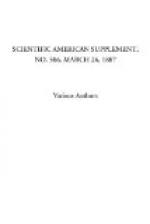No Smoke. CO_{2}. O. CO. 11.7 5.0 Not determined. 13.3 3.7 " 10.8 5.4 " 14.8 2.5 " 13.5 3.0 " 12.4 5.6 " 12.4 4.6 " 13.1 5.9 " 15.3 1.0 " 10.8 4.0 " 14.0 2.8 " ______ ______ Average 12.9 3.9
(11 analyses) ______ ______ 11.5 Not determined. 14.3 " 14.6 "
Damper adjusted so that a slight smoke was observable in the combustion gases.
CO_{2}. O. CO.
17.30 None. Not determined.
16.60 " "
16.50 0.1 "
15.80 0.1 "
16.20 1.8 0.7
_______ _____ _____
Average 16.48 0.4 0.7
—Gas Engineer.
* * * * *
A NEW MERCURY PUMP.
The mercury pumps now in use, whether those of Geissler, Alvergniat, Toepler, or Sprengel, although possessed of considerable advantages, have also serious defects. For instance, Geissler’s pump requires a considerable number of taps, that of Alvergniat and Toepler is very fragile in consequence of its complicated system of tubes connected together, and that of Sprengel is only suitable for certain purposes.
The new mercury pump constructed by Messrs. Greisser and Friedrichs, at Stutzerbach, is remarkable for simplicity of construction and for the ease with which it is manipulated, and also because it enables us to arrive at a perfect vacuum.
The characteristic of this pump is, according to La Lumiere Electrique, a tap of peculiar construction. It has two tubes placed obliquely in respect to its axis, which, when we turn this tap 90 or 180 degrees, are brought opposite one of the three openings in the body of the tap.
Thus the striae that are formed between the hollowed-out parts of the tap do not affect its tightness; and, besides, the turns of the tap have for their principal positions 90 and 180 degrees, instead of 45 and 90 degrees, as in Geissler’s pump.
The working of the apparatus, which only requires the manipulation of a single tap, is very simple. When the mercury is raised, the tap is turned in such a manner that the surplus of the liquid can pass into the enlarged appendage, a, placed above the tap, and communication is then cut off by turning the tap to 90 degrees.
The mercury reservoir having descended, the bulb empties itself, and then the tap is turned on again, in order to establish communication with the exhausting tube. The tap is then closed, the mercury ascends again, and this action keeps on repeating.
[Illustration]
* * * * *




